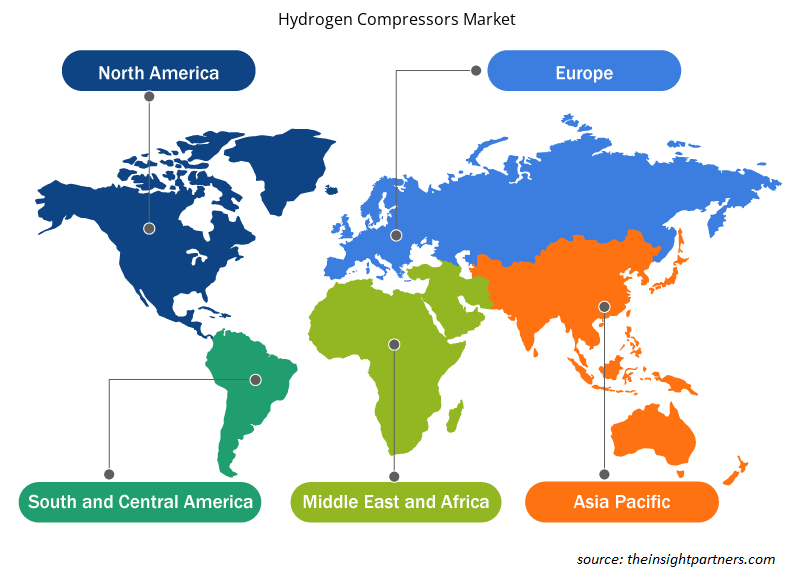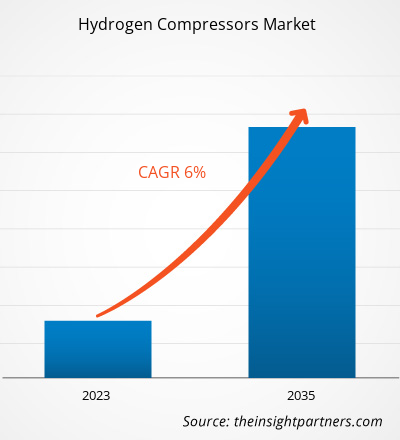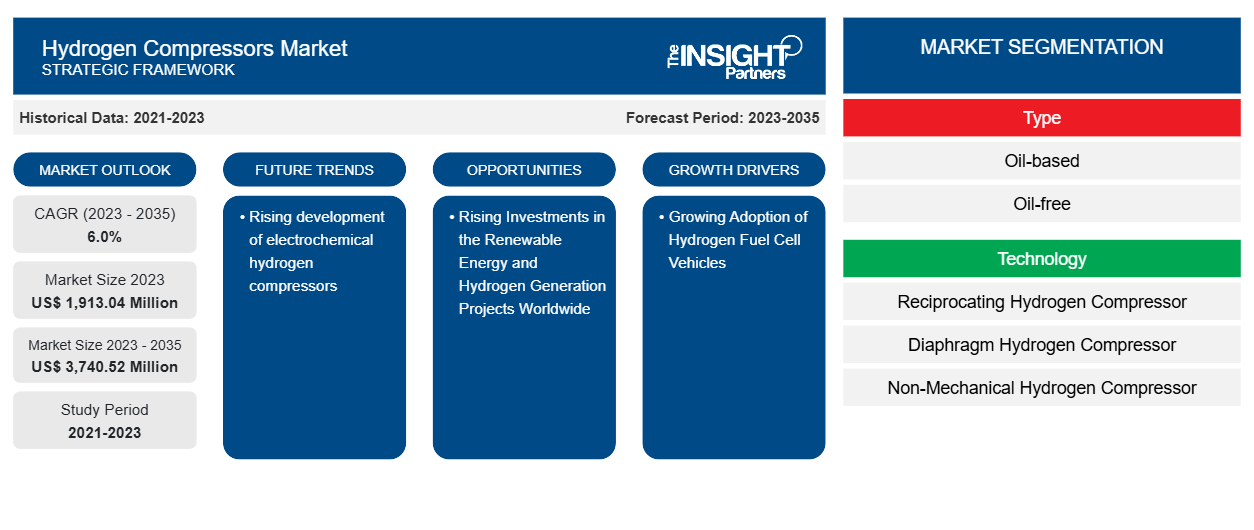Der Markt für Wasserstoffkompressoren soll von 1.913,04 Millionen US-Dollar im Jahr 2023 auf 3.740,52 Millionen US-Dollar im Jahr 2035 anwachsen. Der Markt soll zwischen 2023 und 2035 eine durchschnittliche jährliche Wachstumsrate (CAGR) von 6,0 % verzeichnen. Die zunehmende Umstellung auf grünen Wasserstoff dürfte in den kommenden Jahren neue Trends auf dem Markt mit sich bringen.
Marktanalyse für Wasserstoffkompressoren
Die steigende Verbreitung von Wasserstoff-Brennstoffzellenfahrzeugen und das enorme Wachstum der Öl- und Gas- sowie der chemischen und petrochemischen Industrie weltweit werden voraussichtlich die Nachfrage nach Wasserstoffkompressoren in den kommenden Jahren ankurbeln. Darüber hinaus ist das derzeitige Wachstum des Wasserstoffkompressormarktes auf die Einführung fortschrittlicher Wasserstoffkompressoren zurückzuführen. Die hohen Installations- und Wartungskosten von Wasserstoffkompressoren hemmen jedoch das Marktwachstum. Darüber hinaus wird erwartet, dass die steigenden Investitionen in die Energiebranche und die Entwicklung und Erweiterung der Wasserstoffinfrastruktur weltweit im Prognosezeitraum Chancen für die wichtigsten Akteure auf dem Wasserstoffkompressormarkt schaffen werden. Darüber hinaus wird erwartet, dass die Umstellung auf die Verwendung von grünem Wasserstoff in verschiedenen Branchen der wichtigste zukünftige Trend auf dem Markt sein wird.
Es gibt einen Anstieg der Investitionen im Bereich erneuerbare Energien aufgrund verstärkter staatlicher Initiativen und Finanzierungen, die den Einsatz von Wasserstoffkompressoren fördern. Laut IEA erreichten die weltweiten Investitionen in den Bereich erneuerbare Energien in den ersten sechs Monaten des Jahres 2023 358,0 Milliarden US-Dollar, ein Anstieg von 22 % im Vergleich zum Jahresbeginn und ein Allzeithoch für alle sechs Monate. Unternehmen für erneuerbare Energien im Vergleich zum Vorjahr 2022. Die Risikokapitalfirmen und Private-Equity-Unternehmen weiten ihre Aktivitäten im Bereich erneuerbare Energien aus und erreichten im ersten Quartal 2023 10,4 Milliarden US-Dollar. China hatte im ersten Quartal 2023 den größten Marktanteil mit Investitionen in Höhe von 177 Milliarden US-Dollar, ein Anstieg um 16 % im Vergleich zum ersten Quartal 2022. Außerdem sicherten sich die USA Investitionen in Höhe von ca. 36 Milliarden US-Dollar, gefolgt von Deutschland mit einer Investition von 11,9 Milliarden US-Dollar für den Ausbau des Sektors erneuerbare Energien.
Marktübersicht für Wasserstoffkompressoren
Wasserstoff ist einer der energieeffizientesten Kraftstoffe mit dem höchsten Energiegehalt pro Gewicht und einer Dichte von 90 g pro Kubikmeter unter Umgebungsbedingungen. Um ein funktionales Energiedichteniveau zu erreichen, ist eine effiziente Komprimierung von Wasserstoff erforderlich. Wasserstoffkompressoren werden effektiv eingesetzt, um kleine bis mittlere Mengen Wasserstoff auf hohe Werte zu komprimieren. Je nach Anforderungen werden Wasserstoffkompressoren auch für extrem hohe Drücke eingesetzt, beispielsweise über 5.000 bar (75.000 PSI). Darüber hinaus ist ein Druck von weniger als 250 bar (3.600 PSI) erforderlich, um große Mengen ölfreien Wasserstoffs zu komprimieren, was wiederum den Bedarf an Wasserstoffkompressoren im Prognosezeitraum ankurbeln dürfte.
Passen Sie diesen Bericht Ihren Anforderungen an
Sie erhalten kostenlos individuelle Anpassungen an jedem Bericht, einschließlich Teilen dieses Berichts oder einer Analyse auf Länderebene, eines Excel-Datenpakets sowie tolle Angebote und Rabatte für Start-ups und Universitäten.
- Holen Sie sich die wichtigsten Markttrends aus diesem Bericht.Dieses KOSTENLOSE Beispiel umfasst eine Datenanalyse von Markttrends bis hin zu Schätzungen und Prognosen.
Markttreiber und Chancen für Wasserstoffkompressoren
Zunehmende Verbreitung von Fahrzeugen mit Wasserstoff-Brennstoffzellen
Aufgrund der zunehmenden Besorgnis über die Erschöpfung der natürlichen Ressourcen und die Umweltzerstörung konzentrieren sich die Regierungen verschiedener Länder auf der ganzen Welt kontinuierlich auf die Entwicklung umweltfreundlicher Lösungen für verschiedene Branchen, darunter die Automobilindustrie. Darüber hinaus hat eine Veränderung der Verbraucherpräferenzen aufgrund eines gestiegenen Bewusstseins für die Auswirkungen von Luftverschmutzung und steigendem Verkehrsaufkommen und Treibhausgasemissionen den Bedarf an Wasserstoff-Brennstoffzellenfahrzeugen erhöht. Der Anstieg der staatlichen Investitionen in die Wasserstoff-Brennstoffinfrastruktur und die den Käufern gebotenen Anreize ermöglichen es den Erstausrüstern (OEMs), ihre Einnahmequellen sowie ihre geografische Präsenz zu erweitern. So startete die indische Regierung im Januar 2023 die National Green Hydrogen Mission mit einer Investition von rund 2.000 Millionen US-Dollar. Darüber hinaus nehmen die Forschungs- und Entwicklungsaktivitäten von Fahrzeugherstellern auf der ganzen Welt zu. So brachte Toyota im Dezember 2020 seinen neu gestalteten Mirai auf den Markt. Das Unternehmen aktualisierte eine Reihe interner und externer Funktionen, darunter sein Wasserstoff-Brennstoffzellensystem.
Wasserstoff- Brennstoffzellenfahrzeuge bieten gegenüber herkömmlichen Fahrzeugen mit Verbrennungsmotor eine Reihe von Vorteilen. Brennstoffzellen-Elektrofahrzeuge (FCEVs) bieten einen geringeren Kraftstoffverbrauch als Fahrzeuge mit Verbrennungsmotor (ICE). Das FCEV hat einen Kraftstoffverbrauch von ~63 Meilen pro Gallone Benzinäquivalent (MPGge), und ein ICE-Fahrzeug erreicht 29 MPGge auf der Straße. Die Hybridisierung verbessert den Kraftstoffverbrauch eines FCEV um etwa 3,2 %. Darüber hinaus können die FCEVs fast 300 Meilen ohne Tankstopp zurücklegen. Honda Clarity hat die höchste EPA-Fahrbewertung aller emissionsfreien Fahrzeuge in den USA. Es hat eine Reichweite von bis zu 366 Meilen. Aufgrund dieser Vorteile ist die Nachfrage nach Wasserstoff-Brennstoffzellenfahrzeugen gestiegen. Laut den Daten einer im Mai 2024 veröffentlichten Forschungsarbeit sind beispielsweise Südkorea (19.270) und die USA (12.283) die führenden Länder bei der Einführung von Brennstoffzellenfahrzeugen in den Segmenten Pkw, Busse und Lkw. Staatliche Anreize und Produktentwicklungsaktivitäten wichtiger Akteure für Wasserstofffahrzeuge führen zu einer erhöhten Nachfrage nach Wasserstoffinfrastruktur und treiben letztlich den Markt an.FCEVs) provide improved fuel economy to internal combustion engine (ICE) vehicles. The FCEV has a fuel economy of ~63 miles per gallon gasoline equivalent (MPGge), and an ICE vehicle records 29 MPGge on roads. Hybridization enhances the fuel economy of an FCEV by approximately 3.2%. Moreover, the FCEVs can travel almost 300 miles without refueling. Honda Clarity has the highest EPA driving rating for any zero-emission vehicle in the US. It has a driving range of up to 366 miles. Owing to these benefits, the demand for hydrogen fuel cell vehicles has increased. For instance, as per the data presented in a research paper published in May 2024, South Korea (19,270) and the US (12,283) are the leading countries in fuel cell vehicle adoption in the passenger car, buses, and truck segments. Government incentives and product development activities by key players for hydrogen vehicles are leading to increased demand for hydrogen infrastructure, ultimately driving the market.
Weltweit steigende Investitionen in Projekte für erneuerbare Energien und Wasserstofferzeugung
Mit der zunehmenden Urbanisierung und dem rasanten industriellen Wachstum ist der Energieverbrauch weltweit gestiegen. Um diesen enormen Energiebedarf zu decken, werden immer mehr Projekte zur Erzeugung von Wasserstoffenergie gestartet. Laut der Ember Climate Organization erreichte der weltweite Gesamtenergiebedarf im ersten Quartal 2022 ~13.393 TWh, ein Anstieg von 13.004 TWh gegenüber 2021. Ein solcher Anstieg des Energie- und Strombedarfs aufgrund steigender Anforderungen an die private und industrielle Produktion treibt die Nachfrage nach Wasserstoffkompressoren an. Erneuerbare Energien spielen bei der Stromerzeugung eine bedeutende Rolle. Laut der Internationalen Energieagentur (IEA) wird der weltweite Strombedarf bis 2040 voraussichtlich jährlich um 2,1 % steigen.TWh in the first quarter of 2022, an increase from 13,004 TWh compared to 2021. Such an increase in demand for energy and power, owing to rising residential and industrial manufacturing requirements, is driving the demand for hydrogen compressors. Renewable energy plays a significant role in making electricity. Per the International Energy Agency (IEA), the global demand for electricity is anticipated to increase by 2.1% annually by 2040.
Segmentierungsanalyse des Marktberichts für Wasserstoffkompressoren
Wichtige Segmente, die zur Ableitung der Marktanalyse für Wasserstoffkompressoren beigetragen haben, sind Typ, Technologie und Endbenutzer.
- Basierend auf dem Typ ist der Markt für Wasserstoffkompressoren in geschmierte und ölfreie Kompressoren unterteilt. Das geschmierte Segment hielt im Jahr 2023 einen größeren Marktanteil.
- Basierend auf der Technologie ist der Markt für Wasserstoffkompressoren in Wasserstoff-Kolbenkompressoren, Wasserstoff-Membrankompressoren, nichtmechanische Wasserstoffkompressoren und andere unterteilt. Das Segment der Wasserstoff-Kolbenkompressoren dominierte den Markt im Jahr 2023.nonmechanical hydrogen compressors, and others. The reciprocating hydrogen compressors segment dominated the market in 2023.
- Basierend auf dem Endverbraucher wird der Markt in Kraftwerke, Öl und Gas, Lebensmittel und Getränke, Petrochemie und Chemie, Wasserstofftankstellen, Wasserstoffspeicher und andere unterteilt. Das Petrochemie- und Chemiesegment hatte im Jahr 2023 den größten Marktanteil.
Marktanteilsanalyse für Wasserstoffkompressoren nach Geografie
Der geografische Umfang des Marktberichts für Wasserstoffkompressoren ist hauptsächlich in fünf Regionen unterteilt: Nordamerika, Asien-Pazifik, Europa, Naher Osten und Afrika sowie Süd- und Mittelamerika.
Der nordamerikanische Wasserstoffkompressor ist in die USA, Kanada und Mexiko unterteilt. Das Marktwachstum ist auf eine erhebliche Nachfrage nach Wasserstoffkompressoren aufgrund des Wachstums im Öl- und Gassektor zurückzuführen. Eine gut ausgebaute Infrastruktur in Industrieländern, darunter den USA und Kanada, hilft Fertigungsunternehmen, die Grenzen von Wissenschaft, Technologie und Handel auszuloten. Technologische Fortschritte haben zu einem starken Wettbewerb im Fertigungssektor der Region geführt. Laut dem National Institute of Standards and Technology (NIST) wurde der Fertigungssektor in den USA im Jahr 2023 auf 2,9 Billionen US-Dollar geschätzt, was einem Anteil von 10,0 % am gesamten BIP entspricht. Solche bedeutenden Fertigungs- und Industriesektoren erzeugen eine enorme Nachfrage nach Wasserstoff als sauberem Kraftstoff in Nordamerika, was wiederum den Markt für Wasserstoffkompressoren im Prognosezeitraum ankurbeln dürfte.
Die USA produzieren jährlich etwa 10 Millionen Tonnen Wasserstoff, der hauptsächlich in der Erdölraffination und Ammoniakproduktion verwendet wird. Wasserstoff birgt ein erhebliches Potenzial für die Energieversorgung emissionsfreier Abläufe in chemischen Prozessen, sauberen Energiesystemen und im Transportwesen, um nur einige zu nennen. Wasserstoff entwickelt sich auch als attraktiver Kraftstoff für den Betrieb von Rechenzentren, Häfen, Stahlproduktionsanlagen und mittelschweren bis schweren Lastkraftwagen. Im Januar 2023 kündigte das Energieministerium (DOE) im Rahmen des Infrastructure Investment and Jobs Act eine Investition von 8 Milliarden US-Dollar in Regional Clean Hydrogen Hubs (H2Hubs) an. Diese H2Hubs werden die gesamte Wertschöpfungskette für sauberen Wasserstoff präsentieren und Produktion, Verarbeitung, Lieferung, Speicherung und Endverbrauchsanwendungen fördern. Die Bemühungen des DOE stehen im Einklang mit den ehrgeizigen Zielen der Biden-Administration, bis 2035 ein kohlenstofffreies Stromnetz zu erreichen und bis 2050 zu einer emissionsfreien Wirtschaft überzugehen. Die Finanzierung zielt darauf ab, Fortschritte in der Wasserstofftechnologie und -infrastruktur zu beschleunigen und den Fortschritt hin zu einer nachhaltigeren und umweltfreundlicheren Zukunft in den USA voranzutreiben.
Regionale Einblicke in den Markt für Wasserstoffkompressoren
Die regionalen Trends und Faktoren, die den Markt für Wasserstoffkompressoren im gesamten Prognosezeitraum beeinflussen, wurden von den Analysten von Insight Partners ausführlich erläutert. In diesem Abschnitt werden auch die Marktsegmente und die Geografie von Wasserstoffkompressoren in Nordamerika, Europa, im asiatisch-pazifischen Raum, im Nahen Osten und Afrika sowie in Süd- und Mittelamerika erörtert.

- Holen Sie sich die regionalen Daten für den Wasserstoffkompressorenmarkt
Umfang des Marktberichts zu Wasserstoffkompressoren
| Berichtsattribut | Details |
|---|---|
| Marktgröße im Jahr 2023 | 1.913,04 Millionen US-Dollar |
| Marktgröße bis 2035 | 3.740,52 Millionen US-Dollar |
| Globale CAGR (2023 - 2035) | 6,0 % |
| Historische Daten | 2021-2023 |
| Prognosezeitraum | 2023–2035 |
| Abgedeckte Segmente | Nach Typ
|
| Abgedeckte Regionen und Länder | Nordamerika
|
| Marktführer und wichtige Unternehmensprofile |
|
Marktteilnehmerdichte für Wasserstoffkompressoren: Auswirkungen auf die Geschäftsdynamik verstehen
Der Markt für Wasserstoffkompressoren wächst rasant, angetrieben durch die steigende Endverbrauchernachfrage aufgrund von Faktoren wie sich entwickelnden Verbraucherpräferenzen, technologischen Fortschritten und einem größeren Bewusstsein für die Vorteile des Produkts. Mit steigender Nachfrage erweitern Unternehmen ihr Angebot, entwickeln Innovationen, um die Bedürfnisse der Verbraucher zu erfüllen, und nutzen neue Trends, was das Marktwachstum weiter ankurbelt.
Die Marktteilnehmerdichte bezieht sich auf die Verteilung der Firmen oder Unternehmen, die in einem bestimmten Markt oder einer bestimmten Branche tätig sind. Sie gibt an, wie viele Wettbewerber (Marktteilnehmer) in einem bestimmten Marktraum im Verhältnis zu seiner Größe oder seinem gesamten Marktwert präsent sind.
Die wichtigsten auf dem Markt für Wasserstoffkompressoren tätigen Unternehmen sind:
- Burckhardt Compression AG
- Atlas Copco AB
- Fluitron, Inc.
- Howden-Gruppe
- Gardner Denver Nash
- GmbH
Haftungsausschluss : Die oben aufgeführten Unternehmen sind nicht in einer bestimmten Reihenfolge aufgeführt.

- Überblick über die wichtigsten Akteure auf dem Markt für Wasserstoffkompressoren
Neuigkeiten und aktuelle Entwicklungen zum Markt für Wasserstoffkompressoren
Der Markt für Wasserstoffkompressoren wird durch die Erhebung qualitativer und quantitativer Daten aus Primär- und Sekundärforschung bewertet, die wichtige Unternehmensveröffentlichungen, Verbandsdaten und Datenbanken umfasst. Eine wichtige Entwicklung auf dem Markt für Wasserstoffkompressoren ist unten aufgeführt:
- Howden hat einen Vertrag zur Lieferung von drei Wasserstoff-Membrankompressoren für die Raven SR-Anlage zur Produktion von erneuerbarem Wasserstoff in Richmond, Kalifornien, unterzeichnet. (Quelle: Howden, Pressemitteilung, Juni 2022)
Marktbericht zu Wasserstoffkompressoren – Umfang und Ergebnisse
Der Bericht „Marktgröße und Prognose für Wasserstoffkompressoren (2021–2035)“ bietet eine detaillierte Analyse des Marktes, die die folgenden Bereiche abdeckt:
- Marktgröße und Prognose für Wasserstoffkompressoren auf globaler, regionaler und Länderebene für alle wichtigen Marktsegmente, die im Rahmen des Berichts abgedeckt sind
- Markttrends für Wasserstoffkompressoren sowie Marktdynamik wie Treiber, Einschränkungen und wichtige Chancen
- Detaillierte PEST- und SWOT-Analyse
- Marktanalyse für Wasserstoffkompressoren mit Blick auf wichtige Markttrends, globale und regionale Rahmenbedingungen, wichtige Akteure, Vorschriften und aktuelle Marktentwicklungen
- Branchenlandschaft und Wettbewerbsanalyse, einschließlich Marktkonzentration, Heatmap-Analyse, prominenten Akteuren und aktuellen Entwicklungen auf dem Markt für Wasserstoffkompressoren
- Detaillierte Firmenprofile
- Historische Analyse (2 Jahre), Basisjahr, Prognose (7 Jahre) mit CAGR
- PEST- und SWOT-Analyse
- Marktgröße Wert/Volumen – Global, Regional, Land
- Branchen- und Wettbewerbslandschaft
- Excel-Datensatz
Aktuelle Berichte
Erfahrungsberichte
Grund zum Kauf
- Fundierte Entscheidungsfindung
- Marktdynamik verstehen
- Wettbewerbsanalyse
- Kundeneinblicke
- Marktprognosen
- Risikominimierung
- Strategische Planung
- Investitionsbegründung
- Identifizierung neuer Märkte
- Verbesserung von Marketingstrategien
- Steigerung der Betriebseffizienz
- Anpassung an regulatorische Trends























 Kostenlose Probe anfordern für - Markt für Wasserstoffkompressoren
Kostenlose Probe anfordern für - Markt für Wasserstoffkompressoren